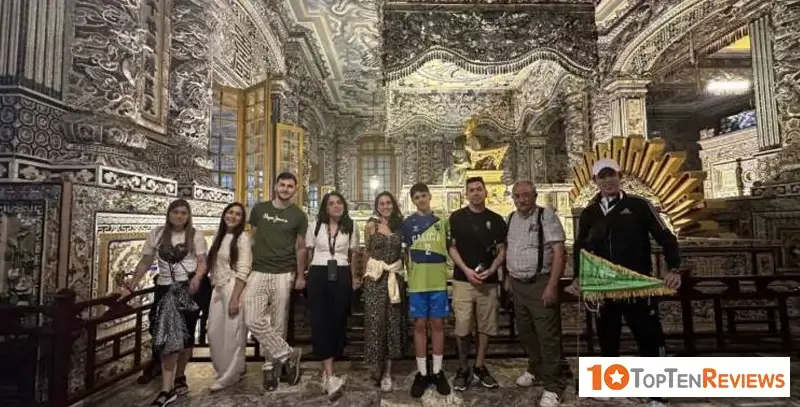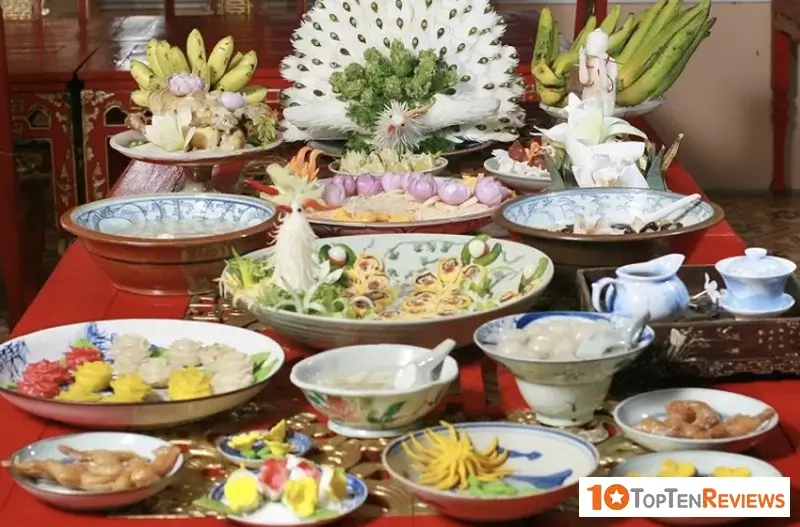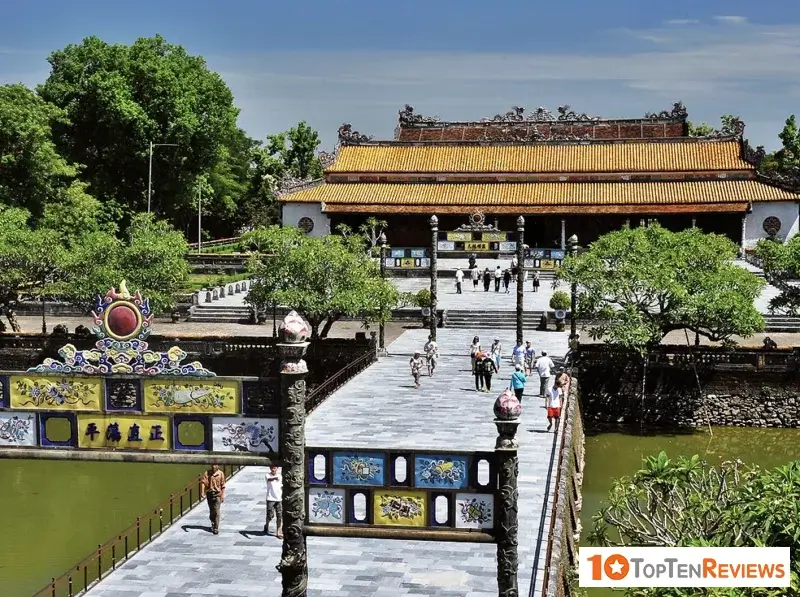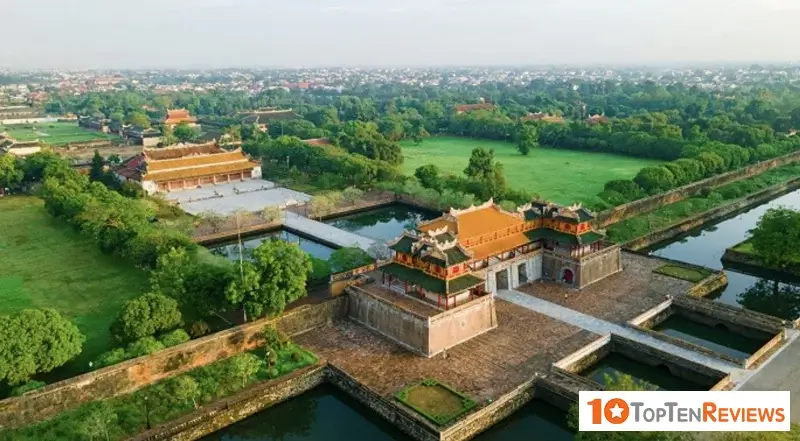Nestled along the gentle curve of the Perfume River, Hue Imperial City stands as a majestic testament to Vietnam's royal past. As we embark on this journey of exploration, let's draw back the curtains of time to reveal the echoes of an era when emperors reigned and dynasties flourished.
A Tapestry of Heritage:
Hue, the ancient imperial capital, is a canvas painted with layers of history, culture, and architectural splendor. Each stone within its walls carries the whispers of emperors, the footfalls of scholars, and the melodies of courtly rituals. Here, the royal legacy of Vietnam comes alive in the intricate architecture, serene gardens, and storied halls that bear witness to a bygone era.
A UNESCO World Heritage Site:
Stepping through the gates of Hue Imperial City isn't merely a stroll through history; it's an immersion into a living heritage. Designated as a UNESCO World Heritage Site, this walled fortress stands as a custodian of the past – a treasure trove that safeguards the essence of Vietnam's imperial glory.
As we tread the cobblestone paths and explore the intricate corridors, we're not just travelers; we're time voyagers. Let the stories of emperors, poets, and artisans echo in our ears as we unveil the splendor of Hue Imperial City, where history comes to life and the symphony of the past resonates in every stone.
1. Delving Deep into the Hue Imperial City Tour: A Voyage through Regal Grandeur

The Imperial Enclosure:
As we step beyond the towering Ngo Mon Gate, the heart of Hue Imperial City opens before us – the Imperial Enclosure. This sprawling expanse of regal magnificence showcases an architectural symphony that leaves visitors in awe. Vast courtyards stretch like tranquil oceans, bridged by ornate walkways that echo with centuries of history. Majestic gates stand as guardians of the past, inviting us to traverse a realm where emperors once ruled and dynasties thrived.
The Forbidden Purple City:
Tucked within the embrace of the Imperial Enclosure lies the enigmatic Forbidden Purple City. This sanctum was more than a residence; it was a realm of utmost secrecy and privilege. Once the innermost haven of the emperor and his family, the Forbidden Purple City holds within its walls the stories of imperial life, rituals, and intrigues. The echoes of laughter and whispers of council meetings linger among its ruins, reminding us of the imperial legacy that once flourished here.
Temples and Pavilions:
Amidst the grandeur of Hue Imperial City, temples and pavilions emerge as jewels that shine with cultural significance. Thai Hoa Palace, the Hall of Supreme Harmony, is a testament to imperial ceremonies and gatherings, with its intricate details reflecting the reverence of the time. The Mieu Temple, dedicated to the Nguyen dynasty's ancestors, stands as a testament to familial reverence and spiritual connection, inviting us to explore the intricate world of imperial beliefs.
Walls and Moats:
Beyond its aesthetic splendor, the city's architecture also served a defensive purpose. Its walls and moats stood as fortifications against external forces, safeguarding the imperial realm from potential threats. These formidable structures are a testament to the strategic acumen of the era, a reminder that even amidst artistic brilliance, the pragmatic necessity of defense was not forgotten.
As we traverse these hallowed grounds, the legacy of emperors and the spirit of a bygone era come alive. The architecture of Hue Imperial City isn't merely stone and wood; it's a living narrative that whispers stories of power, artistry, and the indomitable spirit of Vietnam's royal past.
2. Hue's Royal Cuisine: A Feast for the Senses

Introduction:
Hue's culinary tapestry is woven with threads of history, culture, and the royal legacy that once graced its halls. As we explore the city's flavors, we embark on a journey through time, savoring dishes that were once served in the imperial courts and have since become an integral part of Hue's identity.
Banh Khoai:
Our culinary journey begins with Banh Khoai, a dish that encapsulates Hue's penchant for blending textures and flavors. This crispy pancake is a canvas adorned with succulent shrimp, savory pork, and the crunch of bean sprouts. As you take a bite, you're greeted with a symphony of tastes that reflect both the sophistication of royal cuisine and the earthiness of local ingredients.
Bun Bo Hue:
No exploration of Hue's culinary heritage is complete without savoring Bun Bo Hue, the city's iconic beef noodle soup. Unlike its more famous cousin, pho, Bun Bo Hue boasts a broth that's rich, spicy, and brimming with character. The interplay of tender beef slices, aromatic lemongrass, and the fiery kick of chili creates a harmony that resonates with the region's distinctive flavors.
Royal Banquets:
In the heart of Hue's royal history lies a culinary tradition that's as ornate as it is delectable – the royal banquets. These grand feasts were a celebration of gastronomic artistry, where each dish was meticulously crafted to please both the palate and the eyes. From delicate spring rolls to intricately carved fruits, these banquets were a testament to the intersection of culinary mastery and regal sophistication.
Where to Savor:
To experience the authentic flavors of Hue, venture into its eateries and restaurants that pay homage to its culinary heritage. The bustling Dong Ba Market is a treasure trove of street food stalls, where you can indulge in a variety of local delicacies. Meanwhile, spots like Madame Thu Bon's Restaurant and Lac Thien Restaurant offer a sit-down experience where you can savor the regal flavors in a cozy atmosphere.
As we partake in the symphony of flavors that Hue's royal cuisine offers, we're not just tasting food; we're immersing ourselves in the very essence of a city that celebrates both its history and its culinary prowess.
3. Best Time to Soak in Hue's Imperial Glory

Spring (February to April):
As the winter chill gives way to the warmth of the sun, Hue emerges from its slumber in a burst of vibrant colors. Spring is a time when the city's imperial charm is accompanied by the delicate blossoms of cherry and apricot trees. The mild temperatures make exploring the imperial grounds a pleasant experience, and the city comes alive with traditional festivals that showcase the heart and soul of Hue's culture.
Autumn (September to December):
Autumn descends upon Hue like a gentle embrace, bringing with it cool breezes and the promise of comfortable touring conditions. The rains recede, allowing travelers to roam the imperial city's courtyards and halls without the worry of sudden downpours. This season paints a canvas of golden hues across the landscape, making it a picturesque time to capture the regal magnificence of Hue.
Brief Mention of Summer and Winter:
While the allure of Hue is timeless, the city does face climatic challenges during summer and winter. Summer ushers in the monsoon rains, which can be heavy and persistent, making outdoor exploration less desirable. On the other hand, winter brings cooler temperatures that might require extra layers to fully enjoy the experience. However, for those who don't mind a little rain or chill, these seasons can also offer unique glimpses into Hue's character.
As you plan your journey to soak in Hue's imperial glory, consider the seasons that best align with your preferences and the experiences you seek. Whether it's the blossoms of spring or the tranquil charm of autumn, each season offers a different facet of Hue's timeless splendor.
4. Around the Imperial City: More of Hue's Charm

Tomb of Minh Mang:
Venturing beyond the imperial walls, we encounter the Tomb of Minh Mang, a masterpiece that epitomizes the harmonious blend between man-made structures and the natural world. Set against a backdrop of lush gardens and tranquil lakes, this tomb is a symphony of serenity. The intricate architecture and meticulously landscaped surroundings create an ambiance that resonates with the tranquility of Hue's essence.
Perfume River Cruises:
The Perfume River is more than just a waterway; it's a poetic thread that weaves through Hue's narrative. Embarking on a cruise along this iconic river is an experience that takes us through the heart of the city's history and culture. As the evening sun paints the sky with hues of gold and pink, the Perfume River becomes a mirror that reflects the imperial city's timeless grandeur.
Thien Mu Pagoda:
Rising gracefully against the horizon, the Thien Mu Pagoda stands as a symbol of spiritual devotion and historic significance. This seven-story temple is a testament to Hue's reverence for tradition and its spiritual connection to the heavens. As we climb its steps and reach its zenith, we're rewarded with panoramic views that stretch over the city and the Perfume River, offering a new perspective on Hue's imperial beauty.
Each of these treasures reveals another facet of Hue's charm, extending the embrace of the city beyond its imperial heart. From tranquil tombs to serene river cruises and sacred pagodas, Hue's allure isn't confined to its walls – it permeates the very air, inviting us to explore the layers of enchantment that surround this regal haven.
5. Tips for Travelers: Navigating Hue's Imperial Splendor with Ease

Guided vs. Self-Guided Tours:
When it comes to exploring the regal expanse of Hue, you'll find a choice between guided and self-guided tours. Guided tours offer the advantage of expert insights and historical context provided by knowledgeable guides. They can unveil hidden stories and add depth to your journey. On the other hand, self-guided exploration allows you to set your own pace and explore corners that catch your interest. Consider your preferences and the level of immersion you seek before making your choice.
Getting Around:
Hue's compact layout makes it relatively easy to navigate. For a leisurely experience, consider hopping on a cyclo – a traditional pedal-powered rickshaw – and let a local cyclist take you around the city. Biking is also a popular option, allowing you to blend in with the local rhythm. Taxis are readily available and provide convenient transportation, especially when covering longer distances or when time is of the essence.
Stay:
To make the most of your time in Hue, consider staying in accommodations that offer easy access to the Imperial City. Hotels and guesthouses around Le Loi Street or within the vicinity of the Perfume River provide a convenient base for your explorations. Being centrally located ensures that the city's attractions are at your doorstep, making your imperial adventure seamlessly accessible.
Cultural Respect:
When visiting sacred and historic sites, it's important to show respect to local customs and traditions. Dress modestly, covering shoulders and knees, when entering temples and pagodas. This cultural sensitivity demonstrates an appreciation for the sanctity of these spaces. While capturing photographs is a wonderful way to preserve memories, be mindful of the guidelines at each site and the wishes of locals.
Armed with these tips, you're well-equipped to embark on a journey through the ages within Hue's imperial embrace. Whether you choose the guided path or the trail of independent discovery, remember that the city's regal allure is waiting to unfold before you.
Conclusion: Embracing Hue's Timeless Tapestry
Reflecting on the Timeless Allure:
As our journey through Hue's imperial past draws to a close, we find ourselves immersed in the echoes of a city that wears its history with grace. The tales of emperors, battles, and dynasties are etched into every stone, every archway, and every cobblestone street. Hue is more than a destination; it's a living testament to the passage of time and the resilience of a culture that continues to thrive.
Embrace the Stories:
With every step you take within the Imperial City, you're stepping into a narrative that spans centuries. The ornate gates, the tranquil gardens, and the palatial halls whisper tales of power, intrigue, and artistic brilliance. It's a chance to connect with the past and gain a deeper understanding of the people who shaped the city's destiny.
As you venture beyond the walls of the Imperial City, you'll find that the echoes of history reverberate through every corner of Hue. From serene tombs to the rhythmic flow of the Perfume River, Hue's allure isn't confined to its physical landmarks; it's woven into the very fabric of its being.
So, as you bid farewell to this regal haven, carry with you the stories and memories you've collected along the way. Remember that Hue's beauty isn't just in its architecture or landscapes; it's in the stories that breathe life into its streets and the spirit that continues to thrive within its walls.

